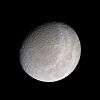Ferdinand (moon)
|
Sequence of discovery images of Ferdinand | |
| Discovery | |
|---|---|
| Discovered by | |
| Discovery date | August 13, 2001[1][2] (confirmed in 2003[1][3]) |
| Orbital characteristics | |
Mean orbit radius | 20,901,000 km[4] |
| Eccentricity | 0.3682 |
| 2887.21 d | |
| Inclination | 170° (to the ecliptic)[5] |
| Satellite of | Uranus |
| Physical characteristics | |
Mean radius | 6 km (estimate)[6] |
| ~1300 km2 (estimate) | |
| Volume | ~4200 km3 (estimate) |
| Mass | ~5.4×1015 kg (estimate) |
Mean density | ~1.3 g/cm3 (assumed) |
| ? | |
| ? | |
| Albedo | 0.04 (assumed)[6] |
| Temperature | ~65 K (estimate) |
|
| |
Ferdinand (/ˈfɜːrdᵻnænd/ FUR-də-nand) is the outermost retrograde irregular satellite of Uranus. It was discovered by Matthew J. Holman, John J. Kavelaars, Dan Milisavljevic, and Brett J. Gladman on August 13, 2001, and given the provisional designation S/2001 U 2.
Despite being seen again on September 21 and November 15 and even a year later on August 13 and September 5, 2002, it was eventually lost. It was finally recovered on September 24, 2003, by Scott S. Sheppard on images obtained by David C. Jewitt and himself on August 29 – 30 and September 20 of that year. Confirming observations were made by Holman on September 30.
Designated Uranus XXIV, it was named after the son of the King of Naples in William Shakespeare's play The Tempest.
Orbit

Ferdinand is the most distant known satellite of Uranus. It follows a retrograde, modestly inclined but highly eccentric orbit. The diagram illustrates the orbital parameters of the retrograde irregular satellites of Uranus (in polar co-ordinates) with the eccentricity of the orbits represented by the segments extending from the pericentre to the apocentre.
See also
References
- 1 2 Green, Daniel W. E. (2003-10-01). "IAUC 8213: S/2001 U 2, S/2002 N 4; C/2003 S4". IAU Circular. Retrieved 2011-01-08.
- ↑ Blue, Jennifer (2008-10-16). "Planet and Satellite Names and Discoverers". Working Group for Planetary System Nomenclature (WGPSN). Retrieved 2008-12-19.
- ↑ Sheppard, Scott S. "New Satellites of Uranus Discovered in 2003". Institute for Astronomy at the University of Hawaii. Retrieved 2008-12-19. Archived January 16, 2009, at the Wayback Machine.
- ↑ Jacobson, R.A. (2003) URA067 (2007-06-28). "Planetary Satellite Mean Orbital Parameters". JPL/NASA. Retrieved 2008-01-23.
- ↑ Sheppard, Jewitt & Kleyna 2005, p. 523, Table 3.
- 1 2 Sheppard, Jewitt & Kleyna 2005, p. 523, Table 3 ... ri (km) ... 10 ... i Radius of satellite assuming a geometric albedo of 0.04.
- Sheppard, S. S.; Jewitt, D.; Kleyna, J. (2005). "An Ultradeep Survey for Irregular Satellites of Uranus: Limits to Completeness". The Astronomical Journal. 129: 518. arXiv:astro-ph/0410059
 . Bibcode:2005AJ....129..518S. doi:10.1086/426329.
. Bibcode:2005AJ....129..518S. doi:10.1086/426329.
External links
- Ferdinand Profile by NASA's Solar System Exploration
- David Jewitt pages
- Uranus' Known Satellites (by Scott S. Sheppard)
- MPC: Natural Satellites Ephemeris Service


